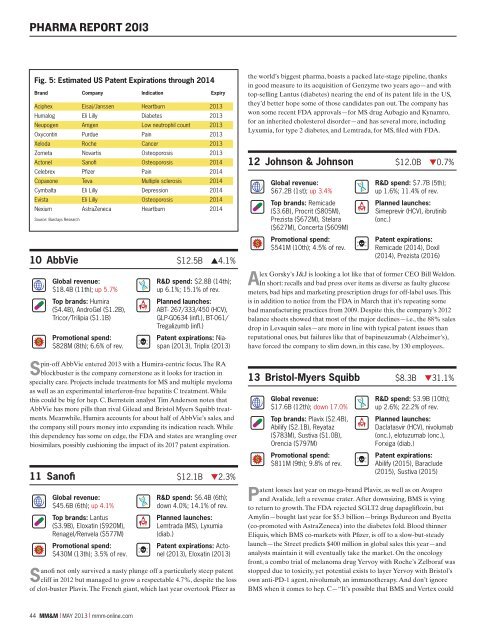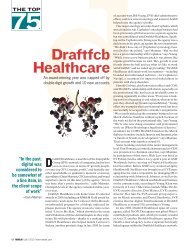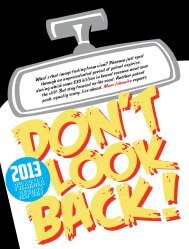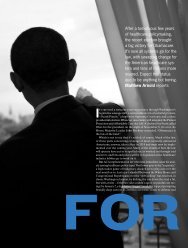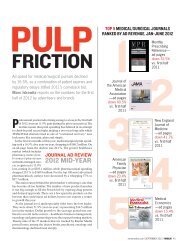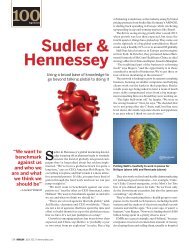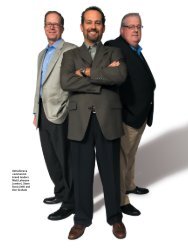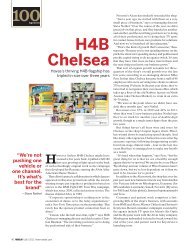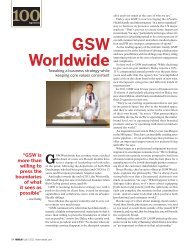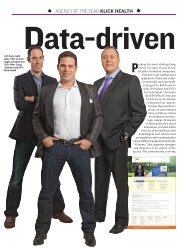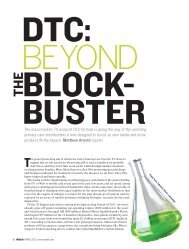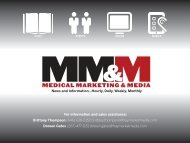LOOK - Medical Marketing and Media
LOOK - Medical Marketing and Media
LOOK - Medical Marketing and Media
Create successful ePaper yourself
Turn your PDF publications into a flip-book with our unique Google optimized e-Paper software.
PHARMA REPORT 2013<br />
Fig. 5: Estimated US Patent Expirations through 2014<br />
Br<strong>and</strong> Company Indication Expiry<br />
Aciphex Eisai/Janssen Heartburn 2013<br />
Humalog Eli Lilly Diabetes 2013<br />
Neupogen Amgen Low neutrophil count 2013<br />
Oxycontin Purdue Pain 2013<br />
Xeloda Roche Cancer 2013<br />
Zometa Novartis Osteoporosis 2013<br />
Actonel Sanofi Osteoporosis 2014<br />
Celebrex Pfizer Pain 2014<br />
Copaxone Teva Multiple sclerosis 2014<br />
Cymbalta Eli Lilly Depression 2014<br />
Evista Eli Lilly Osteoporosis 2014<br />
Nexium AstraZeneca Heartburn 2014<br />
Source: Barclays Research<br />
10 AbbVie $12.5B s4.1%<br />
Global revenue:<br />
$18.4B (11th); up 5.7%<br />
Top br<strong>and</strong>s: Humira<br />
($4.4B), AndroGel ($1.2B),<br />
Tricor/Trilipia ($1.1B)<br />
Promotional spend:<br />
$828M (8th); 6.6% of rev.<br />
44 MM&M x MAY 2013 x mmm-online.com<br />
R&D spend: $2.8B (14th);<br />
up 6.1%; 15.1% of rev.<br />
Planned launches:<br />
ABT- 267/333/450 (HCV),<br />
GLP-G0634 (infl.), BT-061/<br />
Tregalizumb (infl.)<br />
Patent expirations: Niaspan<br />
(2013), Triplix (2013)<br />
Spin-off AbbVie entered 2013 with a Humira-centric focus. The RA<br />
blockbuster is the company cornerstone as it looks for traction in<br />
specialty care. Projects include treatments for MS <strong>and</strong> multiple myeloma<br />
as well as an experimental interferon-free hepatitis C treatment. While<br />
this could be big for hep. C, Bernstein analyst Tim Anderson notes that<br />
AbbVie has more pills than rival Gilead <strong>and</strong> Bristol Myers Squibb treatments.<br />
Meanwhile, Humira accounts for about half of AbbVie’s sales, <strong>and</strong><br />
the company still pours money into exp<strong>and</strong>ing its indication reach. While<br />
this dependency has some on edge, the FDA <strong>and</strong> states are wrangling over<br />
biosimilars, possibly cushioning the impact of its 2017 patent expiration.<br />
11 Sanofi $12.1B t2.3%<br />
Global revenue:<br />
$45.6B (6th); up 4.1%<br />
Top br<strong>and</strong>s: Lantus<br />
($3.9B), Eloxatin ($920M),<br />
Renagel/Renvela ($577M)<br />
Promotional spend:<br />
$430M (13th); 3.5% of rev.<br />
R&D spend: $6.4B (6th);<br />
down 4.0%; 14.1% of rev.<br />
Planned launches:<br />
Lemtrada (MS), Lyxumia<br />
(diab.)<br />
Patent expirations: Actonel<br />
(2013), Eloxatin (2013)<br />
Sanofi not only survived a nasty plunge off a particularly steep patent<br />
cliff in 2012 but managed to grow a respectable 4.7%, despite the loss<br />
of clot-buster Plavix. The French giant, which last year overtook Pfizer as<br />
the world’s biggest pharma, boasts a packed late-stage pipeline, thanks<br />
in good measure to its acquisition of Genzyme two years ago—<strong>and</strong> with<br />
top-selling Lantus (diabetes) nearing the end of its patent life in the US,<br />
they’d better hope some of those c<strong>and</strong>idates pan out. The company has<br />
won some recent FDA approvals—for MS drug Aubagio <strong>and</strong> Kynamro,<br />
for an inherited cholesterol disorder—<strong>and</strong> has several more, including<br />
Lyxumia, for type 2 diabetes, <strong>and</strong> Lemtrada, for MS, filed with FDA.<br />
12 Johnson & Johnson $12.0B t0.7%<br />
Global revenue:<br />
$67.2B (1st); up 3.4%<br />
Top br<strong>and</strong>s: Remicade<br />
($3.6B), Procrit ($805M),<br />
Prezista ($672M), Stelara<br />
($627M), Concerta ($609M)<br />
Promotional spend:<br />
$541M (10th); 4.5% of rev.<br />
R&D spend: $7.7B (5th);<br />
up 1.6%; 11.4% of rev.<br />
Planned launches:<br />
Simeprevir (HCV), ibrutinib<br />
(onc.)<br />
Patent expirations:<br />
Remicade (2014), Doxil<br />
(2014), Prezista (2016)<br />
Alex Gorsky’s J&J is looking a lot like that of former CEO Bill Weldon.<br />
In short: recalls <strong>and</strong> bad press over items as diverse as faulty glucose<br />
meters, bad hips <strong>and</strong> marketing prescription drugs for off-label uses. This<br />
is in addition to notice from the FDA in March that it’s repeating some<br />
bad manufacturing practices from 2009. Despite this, the company’s 2012<br />
balance sheets showed that most of the major declines—i.e., the 88% sales<br />
drop in Levaquin sales—are more in line with typical patent issues than<br />
reputational ones, but failures like that of bapineuzumab (Alzheimer’s),<br />
have forced the company to slim down, in this case, by 130 employees..<br />
13 Bristol-Myers Squibb $8.3B t31.1%<br />
Global revenue:<br />
$17.6B (12th); down 17.0%<br />
Top br<strong>and</strong>s: Plavix ($2.4B),<br />
Abilify ($2.1B), Reyataz<br />
($783M), Sustiva ($1.0B),<br />
Orencia ($797M)<br />
Promotional spend:<br />
$811M (9th); 9.8% of rev.<br />
R&D spend: $3.9B (10th);<br />
up 2.6%; 22.2% of rev.<br />
Planned launches:<br />
Daclatasvir (HCV), nivolumab<br />
(onc.), elotuzumab (onc.),<br />
Forxiga (diab.)<br />
Patent expirations:<br />
Abilify (2015), Baraclude<br />
(2015), Sustiva (2015)<br />
P atent losses last year on mega-br<strong>and</strong> Plavix, as well as on Avapro<br />
<strong>and</strong> Avalide, left a revenue crater. After downsizing, BMS is vying<br />
to return to growth. The FDA rejected SGLT2 drug dapagliflozin, but<br />
Amylin—bought last year for $5.3 billion—brings Bydureon <strong>and</strong> Byetta<br />
(co-promoted with AstraZeneca) into the diabetes fold. Blood thinner<br />
Eliquis, which BMS co-markets with Pfizer, is off to a slow-but-steady<br />
launch—the Street predicts $400 million in global sales this year—<strong>and</strong><br />
analysts maintain it will eventually take the market. On the oncology<br />
front, a combo trial of melanoma drug Yervoy with Roche’s Zelboraf was<br />
stopped due to toxicity, yet potential exists to layer Yervoy with Bristol’s<br />
own anti-PD-1 agent, nivolumab, an immunotherapy. And don’t ignore<br />
BMS when it comes to hep. C—“It’s possible that BMS <strong>and</strong> Vertex could


